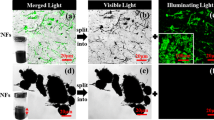Abstract
Soy protein isolate (SPI) has received immense research attention recently for its potential use in biocomposites. As a protein material, SPI is highly complex; it possesses four levels of structure arising from many types of intermolecular interactions. However, practical knowledge on how to alter these interactions to create protein biocomposites with adjustable morphologies is sparse. This study presents one of very few studies on tuning the morphology of protein in biocomposites by modulating these interactions. In this study, SPI/poly(ethylene oxide) (PEO) biocomposites with various morphologies were successfully fabricated by introducing salts (LiClO4, Li2CO3, NaClO4, and NaCl) with different solubilities in PEO and in water into the biocomposite. The results showed that all four salts increased the size of the SPI phase; the magnitude of this effect increased when salts with higher solubility in water were used, and when the salt concentration was increased, in accordance with a greater number of ions available to interact with SPI. Similarly, the salts (LiClO4 and NaClO4) soluble in PEO dramatically reduced the crystallinity of the PEO matrix, resulting in highly stretchable biocomposites; while the salts with poor solubility in PEO (Li2CO3 and NaCl) preferentially distributed in SPI-rich phase and did not show obvious effects on PEO crystalline structures, leading to rigid biocomposites with higher fracture toughness. Importantly, these findings enable the fabrication of protein-based biocomposites with a variety of morphologies for both the protein phase and the polymer phase with great potential to achieve various properties and applications.










Similar content being viewed by others
References
Yu L, Dean K, Li L (2006) Polymer blends and composites from natural resources. Prog Polym Sci 31:576–602
John J, Bhattacharya M (1999) Properties of reactively blended soy protein and modified polyesters. Polym Int 48:1165–1172
Liu WJ, Misra M, Askeland P et al (2005) ‘Green’ composites from soy based plastic and pineapple leaf fiber: fabrication and properties evaluation. Polymer 46:2710–2721
Zhang J, Jiang L, Zhu L (2006) Morphology and properties of soy protein and polylactide blends. Biomacromolecules 7:1551–1561
Kumar P, Sandeep KP, Alavi S et al (2010) Preparation and characterization of bio-nanocomposite films based on soy protein isolate and montmorillonite using melt extrusion. J Food Eng 100:480–489
Bhattacharjee S, Bong D (2011) Protein-polymer grafts via a soy protein derived macro-RAFT chain transfer agent. J Polym Environ 19:203–208
Bondesen B, Schuh M (2001) Circular dichroism of globular proteins. J Chem Ed 78:1244–1247
Salas C, Rojas O, Lucia L et al (2012) Adsorption of glycinin and β-conglycinin on silica and cellulose: surface interactions as a function of denaturation, pH, and electrolytes. Biomacromolecules 13:387–396
Ghorpade VM, Gennadios A, Hanna MA et al (1995) Soy protein isolate/poly(ethylene oxide) films. Cereal Chem 72:559–563
Xu X, Jiang L, Zhou Z et al (2012) Preparation and properties of electrospun soy protein isolate/polyethylene oxide nanofiber membranes. ACS Appl Mater Interfaces 4:4331–4337
Ibrahim S, Yasin SMM, Ahmad R et al (2012) Conductivity, thermal and morphology studies of PEO based salted polymer electrolytes. Solid State Sci 14:1111–1116
Liu Y, Lee JY, Hong L (2003) Morphology, crystallinity, and electrochemical properties of in situ formed poly(ethylene oxide)/TiO2 nanocomposite polymer electrolytes. J Appl Polym Sci 89:2815–2822
Zhang Y, Cremer PS (2006) Interactions between macromolecules and ions: the Hofmeister series. Curr Opin Chem Biol 10:658–663
Bruce PG (1995) Solid state electrochemistry. Cambridge University Press, New York, pp 120–128
Gray FM (1991) Solid polymer electrolytes: fundamentals and technological applications. VCH, New York, p 45
Acknowledgements
The authors wish to acknowledge support from The Franceschi Microscopy and Imaging Center at Washington State University. The authors also appreciate the support from the Composite Materials and Engineering Center at Washington State University.
Author information
Authors and Affiliations
Corresponding author
Rights and permissions
About this article
Cite this article
Eyler, A., Wang, Y., Liu, T. et al. Ion-induced effective control of morphologies of soy protein biocomposites. J Mater Sci 50, 2691–2699 (2015). https://doi.org/10.1007/s10853-015-8816-4
Received:
Accepted:
Published:
Issue Date:
DOI: https://doi.org/10.1007/s10853-015-8816-4




